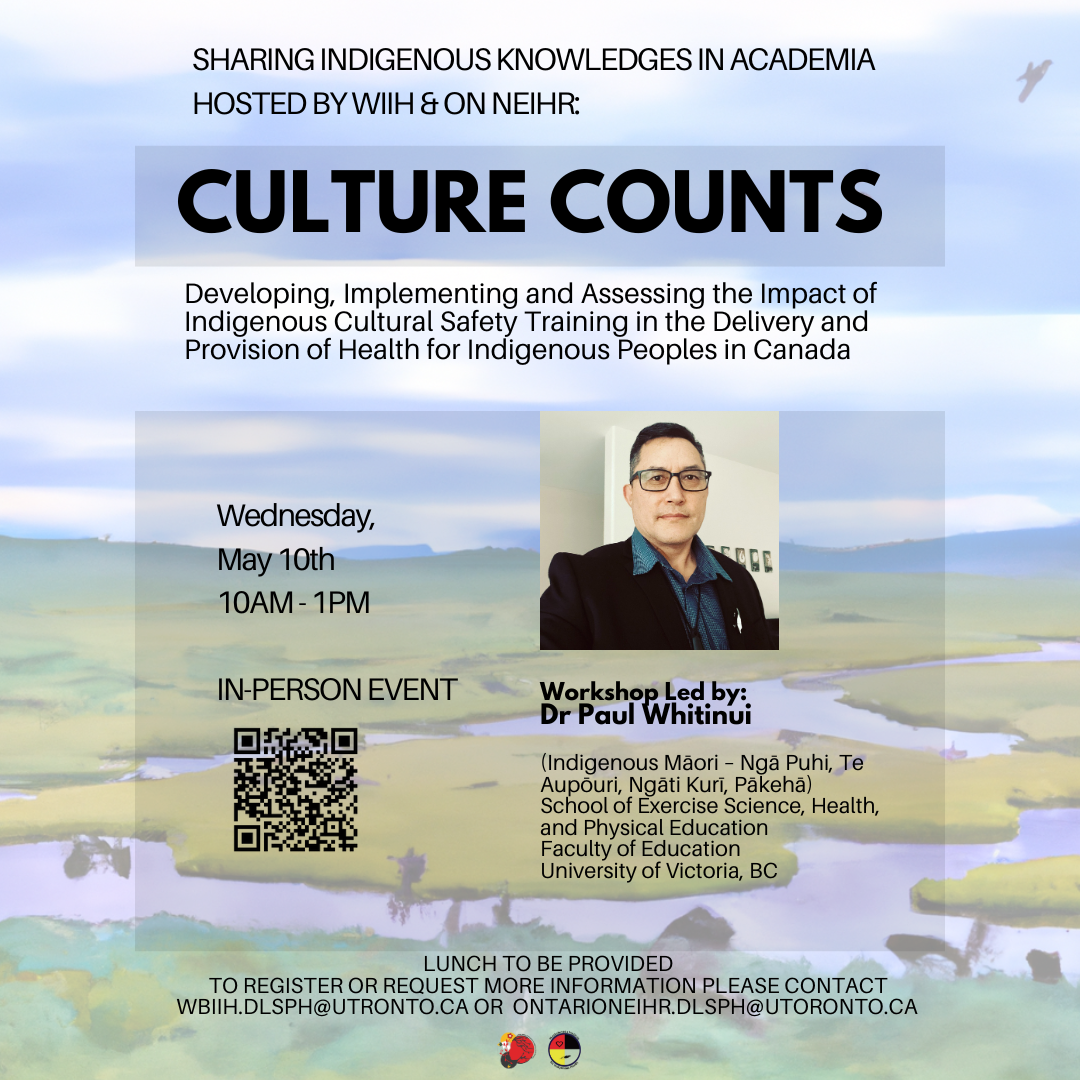- Location
- Upon Registeration
- Series/Type
- DLSPH Event, WIIH Event
- Format
- In-Person
- Dates
- May 10, 2023 from 10:00am to 1:00pm
Links
Culture Counts: Developing, Implementing and Assessing the Impact of Indigenous Cultural Safety Training in the Delivery and Provision of Health for Indigenous Peoples in Canada
Dr. Paul Whitinui
(Indigenous Māori – Ngā Puhi, Te Aupōuri, Ngāti Kurī, Pākehā)
School of Exercise Science, Health, and Physical Education
Faculty of Education
University of Victoria, BC
THIS IS AN IN-PERSON EVENT
Bio:
Dr. Paul Whitinui (he/him pronouns) is an Indigenous Māori scholar from the Confederation of Tribes in the Far North of Aotearoa New Zealand (Ngā Puhi, Te Aupōuri, and Ngāti Kurī) on his father’s side, and Irish, Welsh, English and French (Pākehā) on his mother’s side. He is currently an acting Associate Dean of Graduate Programs and Research in the Faculty of Education at the University of Victoria, B.C., and a Professor in the School of Exercise Science, Physical and Health Education. As an interdisciplinary Indigenous social scientist and educator his work is informed by Kaupapa Māori theory alongside transformative grounded theory and praxis which draws on the lived and emancipatory experiences of iwi Māori, and other colonized Indigenous Peoples, to critically interrogate the dominant colonial state interests in areas pertaining to education, schooling, physical activity, health, sport, and leisure contexts. More recently, Dr. Whitinui has developed in collaboration with four post-secondary institutions on Vancouver Island, an Indigenous cultural safety impact assessment tool to assess the impact of cultural safety training in post-secondary settings, and to build better relationships for teaching and learning with Indigenous students in these contexts.
Abstract:
The messaging Indigenous Peoples receive in society, is that “culture counts”(Bishop & Berryman, 2006; Bishop, 2008). It is also both a simple and powerful message that speaks to the many who organize and participate in the delivery and provision of Indigenous health programs, initiatives, interventions, and activities every day. Captured within this idea, is that enduring and respectful relationships for, with and beside Indigenous Peoples remains of paramount importance to the goal of Indigenous Peoples being well, and able to lead and live active healthy lifestyles. Invariably, developing, implementing, and assessing the impact of Indigenous cultural safety training programs in Canada is as much about determining how culturally safe health is for Indigenous Peoples in Canada, as it is about learning how to improve the quality of health care delivered and provisions supplied. Moreover, the idea that “culture counts” suggest a reduction in culturally unsafe practices and commitment to developing health programs, policies, and processes that are anti-racist and anti-oppressive. In this workshop, the idea of developing an Indigenous cultural safety training impact assessment is about determining whether or not the knowledge or activities facilitated within the training make a difference to one’s personal and professional attitudes (commitment to diversity, accessibility, anti-racism, anti-oppression, and acts of decolonization), models of practice (inclusive excellence), and collective capability (understanding and working towards equity as just, fair). From a perhaps a NEIHR perspective, developing, implementing, and assessing the impact of Indigenous cultural safety training in various health contexts requires a culturally relational and inclusive process that we can all understand and apply in the various health contexts where on-going health disparities, adversities, and inequalities exist. In this regard, I will aim share a four-step culturally iterative and reasoned process related to how to design an Indigenous-informed impact assessment that participants who attend the workshop will have an opportunity to engage with and learn more about. This will also include highlighting an Indigenous cultural safety training impact assessment tool that was developed in collaboration with four post-secondary institutions on Vancouver Island which was then piloted at the University of Victoria in 2022. Finally, this work is more than simply supporting people who work in health to understand the important social and cultural links between Indigenous health and wellbeing, and the collective and relational responsibility we all have to reduce Indigenous health disparities or adversities based on agreed targets (inputs, outputs, outcomes, impacts) we can assess; rather it is about enabling
Indigenous Peoples to take greater responsibility for our own health outcomes, on our own terms. The question we need to ask is, what has the dominant health care system learned about itself from the backlash of the Truth and Reconciliation: Calls to Action”, and what is it going to do to address an equally important question of what does an effective, excellent and optimal health care system for all Canadians, inclusive of Indigenous Peoples enjoying and leading health change as Indigenous Peoples, look like?
Key words: Indigenous cultural safety training, impact assessment development, health provision and delivery, health quality assurance, professional learning, decolonization, Indigenization, anti-racism,
Workshop Goals:
1. To develop health or education impact assessment tools that determine whether specific forms of training, programs, interventions, or activities for Indigenous Peoples is working, or can be further improved or developed;
2. To support and protect Indigenous Peoples in mainstream health, educational or schooling contexts against acts of racism, oppression, alienation, exclusion, or bias;
3. To contribute to acts of reconciliations, resurgence, anti-racism, equity, inclusion, accessibility, diversity, decolonization, anti-colonial, and Indigenization.
Workshop Questions:
1. How would you describe the role and importance of cultural safety training in your institution or organization?
2. How would know the training or intervention or program was effective or not? How would participants demonstrate their learning with their words & actions?
3. What questions would you ask participants who have completed cultural safety training to assess their leaning and goals?
